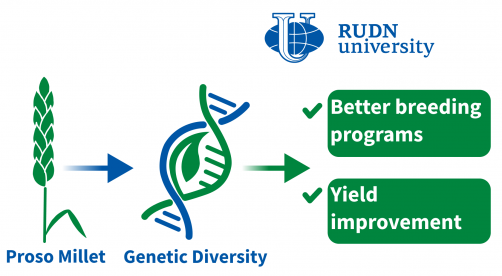Newswise — RUDN University agronomists have built a map of the evolution and genetic diversity of millet. This drought-resistant cereal is underestimated, but new data will help to carry out breeding and increase its yield. The results are published in Agronomy.
Compared to other cereals, millet (Panicum miliaceum L) has an important advantage — resistance to a more arid climate. Millet contains all the essential amino acids, 10-15% of its composition is protein. However, millet yields less than wheat, for example. Therefore, it is planted less often and does not use its full potential. For the same reason, this plant is one of the most poorly studied crops from the point of view of genetics. Meanwhile, knowledge about the genetic diversity of millet will help to grow it more efficiently. To do this, RUDN agronomists have built a complete genetic "map" of millet.
"Millet is an important grain crop. However, it is also the least studied type of cereal, simply because it is not grown much. The genomic base of millet is very limited compared to the main crops. However, understanding the genetic relationships is important for future breeding," Meisam Zargar, Doctor of Agricultural Sciences, Associate Professor of RUDN Agrobiotechnological Department said.
The study was conducted from 2020 to 2022 in the Akmola region in northern Kazakhstan. Agronomists took 100 millet samples from North and South America, East, Central and North Asia, Europe and Southwest Asia and planted them in a dry steppe. To build a "map" of the millet genome, agronomists used so-called microsatellites. These are short sections of DNA, several nucleotides long, which are found in all nuclear cells. They are used as markers by which the kinship and differences of species can be traced.
In total, the agronomists tested 20 microsatellite markers, of which nine were suitable for genomic analysis of millet. With their help, the authors built a phylogenetic tree — a graph reflecting the relationships between species. There were three main clusters in it. Two of them relate mainly to Central Asian genotypes. Samples from Central and North Asia turned out to be the most "tenacious" — their microsatellites were found throughout the tree. Some of their microsatellites turned out to be associated with the beneficial features of millet for cultivation — increased yield and business. These data can be used to breed high-yielding varieties.
"The samples from Central and North Asia are genetically significantly different from other groups. Microsatellites SSR 85 and SR 86 are associated with important agronomic features — productive tillering and grain yield. This will be useful in millet breeding to increase its yield," Meisam Zargar, Doctor of Agricultural Sciences, Associate Professor of RUDN Agrobiotechnological Department said.
